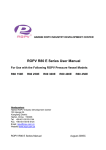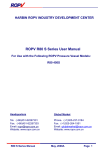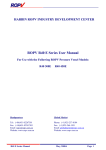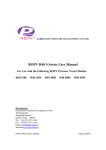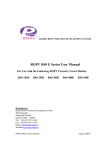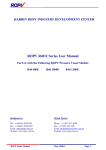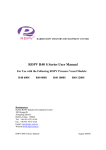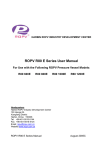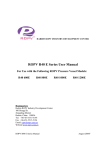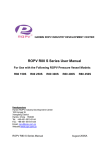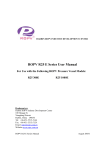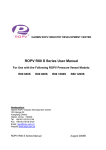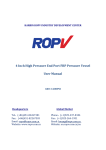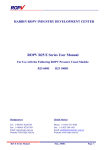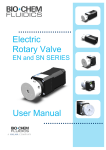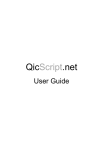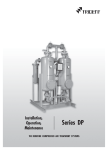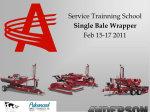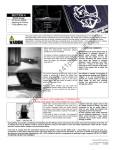Download General Product Description – Model R4040-30E
Transcript
ROPV R80 E Series User Manual For Use with the Following ROPV Pressure Vessel Models: E R80 300 300E E R80 450 450E R80 E Series Manual General Product Description – R80 E Series End Port Membrane Housing R80 300E Design Pressure: R80 450E Design Pressure: 300PSI / 2.1Mpa / 21Bar (at 120°F / 49°C) 450PSI / 3.1Mpa / 31Bar (at 120°F / 49°C) Min. Operating Temp.: Max. Operating Temp.: Factory Test Pressure: 20°F / -6°C 120°F / 49°C ASME: 1.1x Design Pressure Standard: 1.5x Design Pressure 6X Design Pressure 3 – 11 2 – 12 (less than 30 minutes) Burst Pressure: Operating pH Range: Cleaning pH Range: General Warning – High Pressure Membrane Housing ROPV Pressure Vessels are designed to provide safe operation over a long service life if properly installed, operated, and maintained. The vessel may cause loss of life, severe bodily harm, or property damage if not correctly installed, operated, or maintained. Read and understand all guidelines provided in the vessel User Manual. Observe every precaution contained therein. Failure to do so may result in malfunction and potential catastrophic failure. It is recommended that only qualified technicians experienced in servicing hydraulic systems work with this vessel. Misuse, incorrect assembly, or use of damaged/corroded components may result in catastrophic failure. Vessel Use and Precautions • • • • • • • • • • • • • • Positive pressure up to the design pressure (PSI) of the specific model being used. Accommodates standard 8” nominal diameter spiral-wound element. The required vessel/element interface hardware is supplied with the vessel. Ensure that an element adapter is installed at each end of the vessel before use. Vessel expands under pressure and careful consideration must be taken when installing straps/saddles and system connection piping. Installation with the straps/saddles provided is strongly recommended Vessel should not support any other system components. Connections should be non-load bearing. Periodic inspection of the vessel end closure is recommended to ensure all parts are dry and free of corrosion. Failure to understand and follow all precautions may void warranty and result in catastrophic failure of the vessel. These guidelines are subject to change. Please check with ROPV to ensure that the User Manual is the latest version for the vessel model being used. Mount vessel using strap/saddle hardware provided and span recommended in the engineering drawing. Do not over tighten the straps – vessel must be allowed to expand under operation. Maximize the connection flexibility to allow for vessel growth under pressure. Align the end ports with the system manifold, correcting any misalignment before final installation. Provide overpressure protection in the system safety devices. R80 E Series Manual • • • • • • • • • Inspect end closures regularly for signs of corrosion. Immediate corrective action and/or replacement is suggested in case of corrosion. Relieve system pressure before working on the vessel. Do not attempt to over-tighten the Permeate Port connections as this may damage the end closure. One turn past hand tight should be sufficient. Ensure that the Trust Cone is installed on the downstream end of the vessel. Never operate the vessel in excess of its ratings. This may void the warranty and cause bodily or property damage. Do not operate the vessel permeate port over 125PSI. Flush the vessel with permeate before system shutdown to reduce the chance of corrosion. Do not install the vessel in direct sunlight. Operate the vessel within the recommended pH range - Operating pH Range: 3 – 11, Cleaning pH Range: 2 – 12 (less than 30 minutes). R80 E Series Manual Model Explanation R80 E Series Manual Model Specifications R80 E Series Manual Head Removal Step 1 Shut Down System and Relieve System Pressure – The system must be shut down and all pressure relieved before conducting any maintenance or repair on the vessel. Step 2 Disconnect Permeate Piping – The system permeate piping must be carefully removed from the permeate port of the vessel. Step 3 Inspect End Closure – The end closure should be inspected for any signs of corrosion or damage. Surface corrosion can be removed with a wire brush, while flushing with water. Damaged components should be replaced with approved components from ROPV. Step 4 Disconnect Locking Screws – Each of the three locking segments is held in place with a single locking screw. The locking screws can be unthreaded using a standard M6 7/32” hex wrench. The locking screws should be unthreaded from the head only, not from the locking segment. The locking screw and locking segment can be removed together. Step 5 Remove the Locking Segment/Screw Assemblies – The locking segment/screw assemblies should be easily removed from the retaining groove. Should the assemblies be difficult to remove, it may be necessary to rock the head slightly or tap the head inward with a rubber mallet. Be careful when using metal tools, avoiding leveraging against the sidewall of the vessel or scratching the inside surface of the bell area. Step 6 Remove the Head Assembly with One of the Following Techniques ROPV Head Removal Tools – A set of head removal tools is available from ROPV. While not necessary for head removal, they have proven an effective and easy way to remove the vessel head without causing any damage to the vessel. R80 E Series Manual Picture 1 Picture 2 Picture 3 Picture 1 – Detail picture of head removal tools. Picture 2 – Thread the center piece into the permeate port of the head assembly, to hand tight. Do not over tighten the center piece. Picture 3 – Position nut, bearing rod, and bearing block as shown. Turn bearing rod clockwise. The head will move with the bearing rod as it moves toward the end of the vessel. You will be able to remove the head once it has cleared the retaining groove area of the vessel. Alternative Head Removal – It is possible to remove the head assembly without the ROPV head removal tools. The feed/concentrate can be used as a handle to pull the head from the vessel. A strong tug lay be required to break the head seal bond but do not use excess force on the feed/concentrate port. A slight rocking motion will help break the seal bond. Complete Head Assembly with Adapter R80 E Series Manual Head Disassembly and Inspection Step 1 Remove the Head O-ring – Use a non-metallic, rounded tool to start the o-ring out of the o-ring groove. Once a small portion of the o-ring has been lifted out of the groove, use your hand to work the remainder of the o-ring out of the groove. Damaged or cut orings must be replaced during re-installation of the head. Step 2 Remove Adapter – Grasp the adapter and slowly pull from the bearing plate/permeate port. A slight rotating motion may ease the removal of the adapter. There is a set of double o-rings on the inside diameter of the permeate port that must be inspected for damage once the adapter is removed. Damaged o-rings must be replaced before re-installation. Step 3 Remove Bearing Plate – Use a wrench to remove the permeate port Locknut. The locknut is reveres threaded (or left hand threaded) and must be turned clockwise to be removed and counter clockwise to be installed. After removing the locknut, the bearing plate and sealing plate can be separated. Step 4 Remove the Permeate Port – Grasping the sealing plate, rock the permeate port slightly and pull away from sealing plate. It may be necessary to tap the permeate port on the smaller end with a rubber mallet to release the seal bond. Once it is removed, check the sealing plate o-ring seated between the permeate port and the sealing plate. Inspect for damage or foreign matter. Replacement o-rings are recommended during all head rebuilds. R80 E Series Manual Step 5 Remove the Feed/Concentrate Port – Remove the two pieces of feed/concentrate port fixture. Grasping the sealing plate, rock the feed/concentrate port slightly and pull away from sealing plate. It may be necessary to tap the feed/concentrate port on the smaller end with a rubber mallet to release the seal bond. Step 6 Clean All Components – All components should be cleaned with a mild soap solution or clean water. The components should be air dried or dried with a lint-free towel. Step 7 Inspect All Components – All components should be carefully inspected for signs of corrosion and damage. Components exhibiting such should be replaced before reinstallation. All o-rings should be carefully inspected for signs of damage. It is recommended that all o-rings be replaced during each complete servicing of the vessel. Failure to do so may cause poor system performance. Step 8 Inspect Inside Vessel Surface – The inside surface of the vessel should also be inspected once the membrane elements have been removed. Special attention should be paid to identify any scratches, damage or foreign matter. Surface scratches can be repaired by carefully sanding the effected surface with 600-grit sandpaper. A combination of soapy water and fresh water should be used to flush the area during sanding. Clean water should be used to clean the area after sanding. Any extemporaneous matter can be removed with a soft cloth, soapy water, and a clean water flush. Damaged vessels should not be used under any circumstances. Picture of Disassembled Head Components R80 E Series Manual Head Reassembly Step 1 Inspect All Head Components – All head components should be free from scratches, foreign matter, or any sign of damage. Please see Step 6 above for additional information about cleaning head components. Scratched or damaged components should be replaced with ROPV supplied replacement components. All o-rings should be carefully inspected for signs of damage. It is recommended that all o-rings be replaced during each complete servicing of the vessel. Failure to do so may cause poor system performance. Step 2 Install Feed/Concentrate O-rings – All o-rings should be coated with a thin layer of glycerine before installation. Care should be taken to minimize the amount of glycecrine and any excess should be removed. One o-ring should be placed into each of the two grooves located on the inside diameter of the feed/concentrate port hole in the sealing plate. Make sure o-rings are completely seated in the grooves. Step 3 Install Permeate Port O-rings – One o-ring should be placed at the base of the threaded side of the port, at the larger diameter section of the port that seats against the sealing plate. One o-ring should be placed in each of the two grooves on the inside diameter of the permeate port side that is not threaded. Step 4 Assemble Sealing plate and Permeate Port – Push the sealing plate down onto the permeate port with the sealing plate o-ring toward the top or threaded end of the permeate port. It may be necessary to use your body weight to seat the sealing plate. Step 5 Assemble Feed/Concentrate Port – Place the feed/concentrate port in the sealing R80 E Series Manual plate opening and secure using the two feed/concentrate port fixtures. Step 6 Assemble the Bearing Plate – Position the bearing plate over the sealing plate, pushing them together so that the threaded portion of the permeate port is visible. Step 7 Thread Lock Nut Onto Permeate Port – Lock nut should be tightened to handtightness using a wrench for the final half-turn. Do not over tighten the Lock Nut – maximum torque guideline: 15Nm. Note that the threads of the Permeate Port are reverse or left-hand threaded. Step 8 Install Adapter O-rings – All o-rings should be coated with a thin layer of glycerine before installation. Care should be used to minimize the amount or glycerine applied and any excess should be removed. Seat one permeate port o-ring into each of the two grooves located at the element end, outside diameter of the adapter. Step 9 Install Adapter – The adapter should be pushed into the permeate port until the wider diameter middle section is flush against the end of the permeate port. Simultaneously pushing and turning the adapter will ease installation. R80 E Series Manual Step 10 Install Head O-ring – All o-rings should be coated with a thin layer of glycerine before installation. Seat the head o-ring into the groove on the outside diameter of the head. Complete Head Assembly with Adapter R80 E Series Manual Head Installation Step 1 Follow All Steps Outlined in the Head Reassembly Section Step 2 Install Head – Hold the head assembly with both hands, square to the axis of the vessel. Push firmly with both hands until the head is correctly positioned and the retaining groove is visible. It may be necessary to use a rubber mallet to tap the head into its engaged position. The thrust cone must be installed with the head at the downstream end of the vessel. Step 3 Install Locking Kit Segments – Clean and dry the retaining groove. Position the first locking segment so that the end section sits in the retaining groove and the screw aligns with one of the threaded openings in the bearing plate. Use an M6 / 7/32” hex wrench to tighten the screw until snug. Do not over-tighten – maximum torque guideline: 10Nm. Install the two other segments in the same manner. Conduct a final tightness check of each screw after all three segments are installed. 4 Reconnect Permeate Piping – Reconnect the system permeate piping to the Step Step4 permeate port. 5 Pressurize System – A thorough pre-pressurization inspection should be Step Step5 conducted, including verifying that the heads are properly installed, system piping connections are in place, elements are installed, adapters are installed, and thrust cone is installed at downstream end of the vessel. Step 6 Inspect for Leaks – All connections should be free from leaks. Do not operate leaking vessels. R80 E Series Manual Piping and Mounting Recommendations ™ connections or flexible hose at each end. U-bend pipe with two flexible Victaulic Victaulic™ Do not force any connections. The Header and related piping should be self-supported. Space strap/saddle locations using “S” dimension shown in model engineering drawing. -4 and longer vessels have a third strap/saddle assembly, to be installed at the center point of the vessel. Tighten straps to hand tightness plus one turn. Manifold span should be greater than vessel span to allow for vessel growth under pressure. R80 E Series Manual Drawings R80B 300E R80B 450E
















